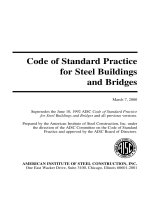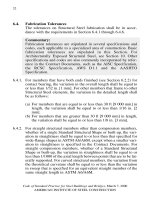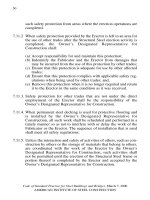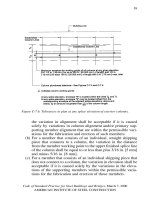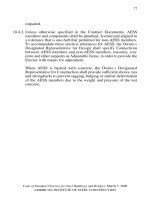ASTM D75/D75M-19 Standard Practice for Sampling Aggregates
Bạn đang xem bản rút gọn của tài liệu. Xem và tải ngay bản đầy đủ của tài liệu tại đây (317.76 KB, 7 trang )
This international standard was developed in accordance with internationally recognized principles on standardization established in the Decision on Principles for the
Development of International Standards, Guides and Recommendations issued by the World Trade Organization Technical Barriers to Trade (TBT) Committee.
Designation: D75/D75M − 19 American Association State
Highway and Transportation
Officials Standard
AASHTO No.: T2
Standard Practice for
Sampling Aggregates1
This standard is issued under the fixed designation D75/D75M; the number immediately following the designation indicates the year
of original adoption or, in the case of revision, the year of last revision. A number in parentheses indicates the year of last reapproval.
A superscript epsilon (´) indicates an editorial change since the last revision or reapproval.
1. Scope* 1.5 This international standard was developed in accor-
dance with internationally recognized principles on standard-
1.1 This practice covers sampling of coarse and fine aggre- ization established in the Decision on Principles for the
gates for the following purposes: Development of International Standards, Guides and Recom-
mendations issued by the World Trade Organization Technical
1.1.1 Preliminary investigation of the potential source of Barriers to Trade (TBT) Committee.
supply,
2. Referenced Documents
1.1.2 Control of the product at the source of supply, 2.1 ASTM Standards:2
1.1.3 Control of the operations at the site of use, and C702/C702M Practice for Reducing Samples of Aggregate
1.1.4 Acceptance or rejection of the materials. to Testing Size
D8 Terminology Relating to Materials for Roads and Pave-
NOTE 1—Sampling plans and acceptance and control tests vary with the ments
type of construction in which the material is used. D2234/D2234M Practice for Collection of a Gross Sample
of Coal
1.2 The text of this standard references notes and footnotes D3665 Practice for Random Sampling of Construction Ma-
which provide explanatory material. These notes and footnotes terials
(excluding those in tables and figures) shall not be considered D3666 Specification for Minimum Requirements for Agen-
as requirements of the standard. cies Testing and Inspecting Road and Paving Materials
E105 Practice for Probability Sampling of Materials
1.3 The values stated in either SI units or inch-pound units E122 Practice for Calculating Sample Size to Estimate, With
are to be regarded separately as standard. The values stated in Specified Precision, the Average for a Characteristic of a
each system may not be exact equivalents; therefore, each Lot or Process
system shall be used independently of the other. Combining E141 Practice for Acceptance of Evidence Based on the
values from the two systems may result in nonconformance Results of Probability Sampling
with the standard.
3. Terminology
NOTE 2—The quality of the results produced by this standard are
dependent on the competence of the personnel performing the procedure 3.1 Definitions—For definitions of terms used in this
and the capability, calibration, and maintenance of the equipment used. practice, refer to Terminology D8.
Agencies that meet the criteria of Specification D3666 are generally
considered capable of competent and objective testing, sampling, 4. Significance and Use
inspection, etc. Users of this standard are cautioned that compliance with
Specification D3666 alone does not completely ensure reliable results. 4.1 Sampling is equally as important as the testing, and the
Reliable results depend on many factors; following the suggestions of sampler shall use every precaution to obtain samples that will
Specification D3666 or some similar acceptable guideline provides a show the nature and condition of the materials which they
means of evaluating and controlling some of those factors. represent.
1.4 This standard does not purport to address all of the 4.2 Samples for preliminary investigation tests are obtained
safety concerns, if any, associated with its use. It is the by the party responsible for development of the potential
responsibility of the user of this standard to establish appro-
priate safety, health, and environmental practices and deter- 2 For referenced ASTM standards, visit the ASTM website, www.astm.org, or
mine the applicability of regulatory limitations prior to use. contact ASTM Customer Service at For Annual Book of ASTM
Standards volume information, refer to the standard’s Document Summary page on
1 This practice is under the jurisdiction of ASTM Committee D04 on Road and the ASTM website.
Paving Materials and is the direct responsibility of Subcommittee D04.30 on
Methods of Sampling.
Current edition approved Nov. 1, 2019. Published November 2019. Originally
approved in 1920. Last previous edition approved in 2014 as D75/D75M – 14. DOI:
10.1520/D0075_D0075M-19.
*A Summary of Changes section appears at the end of this standard
Copyright © ASTM International, 100 Barr Harbor Drive, PO Box C700, West Conshohocken, PA 19428-2959. United States
1
D75/D75M − 19
source (Note 3). Samples of materials for control of the veyor belt while the sample increments are being obtained.
production at the source or control of the work at the site of use Insert two templates, the shape of which conforms to the shape
are obtained by the manufacturer, contractor, or other parties of the belt in the aggregate stream on the belt, and space them
responsible for accomplishing the work. Samples for tests to be such that the material contained between them will yield an
used in acceptance or rejection decisions by the purchaser are increment of the required weight (see Fig. 1). Carefully scoop
obtained by the purchaser or his authorized representative. all material between the templates into a suitable container and
collect the fines on the belt with a brush and dust pan and add
NOTE 3—The preliminary investigation and sampling of potential to the container.
aggregate sources and types occupies a very important place in determin-
ing the availability and suitability of the largest single constituent entering NOTE 5—Automatic belt samplers may be used as long as they are
into the construction. It influences the type of construction from the properly maintained, and regular inspection ensures all material is being
standpoint of economics and governs the necessary material control to removed from the belt (see Fig. 2).
ensure durability of the resulting structure, from the aggregate standpoint.
This investigation should be done only by a responsible, trained, and 5.3.3 Sampling from Stockpiles—Avoid sampling coarse
experienced person. For more comprehensive guidance, see the appen- aggregate or mixed coarse and fine aggregate from stockpiles
dixes. whenever possible, particularly when the sampling is done for
the purpose of determining aggregate properties that may be
5. Securing Samples dependent upon the grading of the sample. If circumstances
make it necessary to obtain samples from a stockpile of coarse
5.1 General—Where practicable, samples to be tested for aggregate or a stockpile of combined coarse and fine aggregate,
quality shall be obtained from the finished product. Samples design a sampling plan for the specific case under consider-
from the finished product to be tested for abrasion loss shall not ation to ensure that segregation does not introduce a bias in the
be subject to further crushing or manual reduction in particle results. This approach will allow the sampling agency to use a
size in preparation for the abrasion test unless the size of the sampling plan that will give a confidence in results obtained
finished product is such that it requires further reduction for therefrom that is agreed upon by all parties concerned to be
testing purposes. acceptable for the particular situation. The sampling plan shall
define the number of samples necessary to represent lots and
5.2 Inspection—The material to be sampled shall be visually sublots of specific sizes. The sampling plan shall also define
inspected to determine discernible variations. If any discernible any specialized site-specific sampling techniques or procedures
variations are noted, corrective action shall be taken to estab- that are required to ensure unbiased samples for existing
lish homogeneity in the material prior to sampling. If it is conditions. The owner and supplier shall agree upon the use of
necessary to indicate the degree of variability existing within any specialized site-specific techniques or procedures. When
the main pile, separate samples shall be drawn from separate site-specific techniques or procedures are developed for sam-
areas of the pile. The seller shall provide suitable equipment pling a stockpile, those procedures shall supersede the proce-
needed for proper inspection and sampling. dures given in 5.3.3.1. (Note 6). General principles for sam-
pling from stockpiles are applicable to sampling from trucks,
5.3 Procedure: rail cars, barges, or other transportation units.
5.3.1 Sampling from a Flowing Aggregate Stream (Bins or
Belt Discharge)—Select units to be sampled by a random NOTE 6—Specific site sampling plans may include the number of
method, such as Practice D3665, from the production. Obtain sampling increments (loader buckets) required to construct the sampling
at least three approximately equal increments, selected at pad.
random from the unit being sampled, and combine to form a
field sample whose mass equals or exceeds the minimum 5.3.3.1 Sampling from Stockpiles with Power Equipment
recommended in 5.4.2. Take each increment from the entire (preferred)—In sampling material from stockpiles it is very
cross section of the material as it is being discharged. It is difficult to ensure unbiased samples due to the segregation
usually necessary to have a special device constructed for use
at each particular plant. This device consists of a pan of FIG. 1 Belt Sampling Template
sufficient size to intercept the entire cross section of the
discharge stream and hold the required quantity of material
without overflowing. A set of rails may be necessary to support
the pan as it is passed under the discharge stream. Insofar as is
possible, keep bins continuously full or nearly full to reduce
segregation.
NOTE 4—Sampling the initial discharge or the final few tons from a bin
or conveyor belt increases the chances of obtaining segregated material
and should be avoided.
5.3.2 Sampling from the Conveyor Belt—Select units to be
sampled by a random method, such as Practice D3665, from
the production. Obtain at least three approximately equal
increments, selected at random, from the unit being sampled
and combine to form a field sample whose mass equals or
exceeds the minimum recommended in 5.4.2. Stop the con-
2
D75/D75M − 19
FIG. 2 Automatic Belt Sampler the entire flat area, but avoid sampling within 0.3 m [1 ft] of the
sample pad edge. Divide the sample pad into four quadrants
which often occurs when material is stockpiled, with coarser and sample equal amounts of materials evenly across each
particles rolling to the outside base of the pile. For coarse or quadrant. Fully insert the shovel as near vertical as possible
mixed coarse and fine aggregate, every effort shall be made to then gently roll the shovel back and lift slowly to avoid coarse
enlist the services of power equipment to develop a separate material rolling off the sides of the shovel (Note 7). Obtain
small sampling pile. additional shovelfuls from different quadrants of the sampling
pad, and in areas that avoid previous “shovel holes.”
(1) When obtaining a sample from a stockpile for accep-
tance testing, a loader shall enter the stockpile nearest the area NOTE 7—Square-tip shovels with the outer edges rolled up approxi-
representing material that is currently being shipped or loaded mately 50 mm [2 in.] on each side work well in preventing material from
into a production facility, with the bucket approximately rolling from the side. Spade-tip shovels are not recommended.
150 mm [6 in.] above ground level, never allowing the front
tires of the loader to ramp up on the pile. Without backing up, 5.3.3.2 Sampling from Stockpiles Without Power Equip-
the loader shall lift the full bucket of material then tilt the ment:
bucket down to gently roll the material out of the bucket back
onto the pile, thus re-blending any segregated material on the NOTE 8—Sampling coarse aggregate and coarse and fine mixed
outside surface of the pile. If prior visual inspection noted aggregate stockpiles without the aid of power equipment is not advised.
discernible variation, or if the loader is not of sufficient size to
cause a cascading effect down the face of the pile during this (1) Where power equipment is not available, samples from
remixing process, several buckets of material shall either be stockpiles shall be made up of at least three increments taken
remixed or removed and discarded to prevent use of potentially from the top third, at the mid-point, and bottom third of the
injurious material. elevation of the stockpile.
(2) After re-blending, the loader shall re-enter the (2) Shove a board vertically into the pile just above the
stockpile, as before, and obtain a full loader bucket of the sampling point to prevent coarser material from rolling down
re-blended material, tilt back, and lift the bucket only high and further segregating the material and biasing the sample.
enough to back up slightly. The board shall be of ample size to prevent material from
cascading down into the sampling area.
(3) At the base of the main stockpile with the bucket only
high enough to permit free-flow of the material from the (3) With the board in place, scrape off the outermost
bucket, the loader operator shall tilt the bucket forward to surface of the pile with the shovel, then insert the shovel
gently roll the material out of the bucket, forming a small perpendicular to the angle of the pile, into the freshly exposed
sampling pile. If the loader bucket is not of sufficient size to material to obtain the sample. Repeat this process across the
create a sample pad of representative size, multiple buckets face of the stockpile until the recommended minimum field
shall be used, dumped on top of each other and back-dragged sample size in 5.4.2 is obtained but no less than the three
to form a single sample pad. increments described in 5.3.3.2(1).
(4) At this point the loader operator shall raise the bucket, 5.3.3.3 Sampling Fine Aggregate from Stockpiles (Alterna-
drive forward far enough to reach across the small pile with the tive Method for Fine Aggregate Only)—When sampling fine
loader bucket without allowing the loader tires to ramp up on aggregate from a stockpile, the outer layer, which easily
the sampling pile, lower the bucket to about half the height of becomes segregated by wind and rain during stockpile storage,
the small pile, and backup, therefore creating a flat surface for shall be removed and the sample taken from the material
sampling (see Fig. 3). The loader shall only back-drag the beneath.
small pile once. This flat surface provides a stable and safe area
to obtain a representative sample. (1) Sampling tubes approximately 30 mm [1.25 in.] mini-
mum by 2 m [6 ft] in length shall be inserted into the shipping
(5) Place the sample bucket(s) near the center of the flat, face of the stockpile horizontally at random locations.
oval-shaped sampling pad. The sample shall be obtained across
NOTE 9—A sampling tube can be constructed of aluminum, PVC, or
other sturdy material. The tip being inserted into the pile can be cut at a
45° angle to ease insertion.
(2) Sample shall be taken at a minimum height of 3 ft from
the surrounding grade.
(3) A minimum of five tube insertions randomly spaced
across the face of the stockpile shall form a single field sample
(see Fig. 4). Ensure that the minimum field sample size
recommended in 5.4.2 is obtained.
5.3.4 Sampling from Transportation Units—Avoid sampling
coarse aggregate or mixed coarse and fine aggregate from
transportation units whenever possible, particularly when the
sampling is done for the purpose of determining aggregate
properties that may be dependent upon the grading of the
sample. If circumstances make it necessary to obtain samples
from a transportation unit, design a sampling plan for the
specific case under consideration to ensure that segregation
3
D75/D75M − 19
FIG. 3 Five-Step Photographic Sequence of Constructing Sampling Pad from Stockpile of Aggregate
FIG. 4 Sampling Fine Aggregate from Stockpile Using Sampling Tube
does not introduce a bias in the results. This approach will a confidence in results obtained therefrom that is agreed upon
allow the sampling agency to use a sampling plan that will give by all parties concerned to be acceptable for the particular
4
D75/D75M − 19
situation. The sampling plan shall define the number of 5.3.5.3 A metal template placed over the area will aid in
samples necessary to represent lots and sublots of specific securing approximately equal increment weights. Place the
sizes. General principles for sampling from stockpiles are template on top of the material to be sampled. Sample material
applicable to sampling from trucks, rail cars, barges, or other from the center of the template. As material is extracted from
transportation units. the center of the template, the template is continuously lowered
to prevent the material outside of the template from falling into
NOTE 10—Sampling from transportation units should be avoided if at the sample hole. The template shall be composed of metal or
all possible. In sampling material from transportation units it is very other sturdy material, no less than 0.3 m [12 in.] in diameter
difficult to ensure unbiased samples, due to the segregation which often and 0.25 m [9 in.] in height, providing a sampling area not less
occurs when material is transported, with coarser particles rolling to the than 0.07 m2 [110 in.2] (see Fig. 5).
outside and finer particles settling.
5.4 Number and Masses of Field Samples:
5.3.4.1 In sampling coarse aggregates from railroad cars or 5.4.1 The number of field samples (obtained by one of the
barges, effort shall be made to enlist the services of power methods described in 5.3) required depends on the criticality
equipment capable of exposing the material at various levels of, and variation in, the properties to be measured. Designate
and random locations. each unit from which a field sample is to be obtained prior to
sampling. The number of field samples from the production
5.3.4.2 Where power equipment is not available, a common shall be sufficient to give the desired confidence in test results.
procedure requires excavation of three or more trenches using
a shovel across the unit at points that will, from visual NOTE 11—Guidance for determining the number of samples required to
appearance, give a reasonable estimate of the characteristics of obtain the desired level of confidence in test results may be found in
the load. The trench bottom shall be approximately level, at Practices D2234/D2234M, E105, E122, and E141.
least 0.3 m [1 ft] in width and in depth below the surface.
5.4.2 The field sample masses cited are tentative. The
5.3.4.3 A minimum of three increments from approximately masses must be predicated on the type and number of tests to
equally spaced points along each trench shall be taken by which the material is to be subjected and sufficient material
pushing a shovel downward into the material. obtained to provide for the proper execution of these tests.
Standard acceptance and control tests are covered by ASTM
5.3.4.4 Coarse aggregate in trucks shall be sampled in standards and specify the portion of the field sample required
essentially the same manner as for rail cars or barges, except for each specific test. Generally speaking, the amounts speci-
for adjusting the number of increments according to the size of fied in Table 1 will provide adequate material for routine
the truck. grading and quality analysis. Extract test portions from the
field sample according to Practice C702/C702M or as required
5.3.4.5 For fine aggregate in transportation units, sampling by other applicable test methods.
tubes as described in 5.3.3.3, except inserted vertically, may be
used to extract an appropriate number of increments from the 6. Shipping Samples
trenches to form the field sample.
6.1 Transport aggregates in bags or other containers so
5.3.5 Sampling from Roadway (Bases and Subbases): constructed as to preclude loss or contamination of any part of
5.3.5.1 Sample units selected by a random method, such as the sample, or damage to the contents from mishandling during
Practice D3665, from the construction. shipment.
5.3.5.2 Obtain at least three approximately equal
increments, selected at random from the unit being sampled, 6.2 Shipping containers for aggregate samples shall have
after the material has been placed and prior to compaction, and suitable individual identification attached and enclosed so that
combine to form a field sample whose mass equals or exceeds field reporting, laboratory logging, and test reporting may be
the minimum recommended in 5.4.2. Take all increments from facilitated.
the roadway for the full depth of the material, taking care to
exclude any underlying material. Clearly mark the specific
areas from which each sample increment is to be removed.
FIG. 5 Proper Use of Metal Template For Sampling Mixed Coarse and Fine Aggregate From Roadway Grade
5
D75/D75M − 19
TABLE 1 Minimum Size of Field Samples
Aggregate SizeA Field Sample Mass, Field Sample Volume,
min, kgB [lb] min, L [gal]
2.36 mm [No. 8] Fine Aggregate 8 [2]
4.75 mm [No. 4] 10 [22] 8 [2]
10 [22]
9.5 mm [" in.] 8 [2]
12.5 mm [½ in.] Coarse Aggregate 12 [3]
19.0 mm [3⁄4 in.] 10 [22] 20 [5]
25.0 mm [1 in.] 15 [35] 40 [10]
37.5 mm [1½ in.] 25 [55] 60 [15]
50 [110] 80 [21]
50 mm [2 in.] 75 [165] 100 [26]
63 mm [2½ in.] 120 [32]
75 mm [3 in.] 100 [220] 140 [37]
90 mm [3½ in.] 125 [275]
150 [330]
175 [385]
A For processed aggregates, use the nominal maximum size as indicated by the appropriate specification or description. If the specification or description does not indicate
a nominal maximum size (for example, a sieve size indicating 90 to 100 % passing), use the maximum size (that sieve indicating 100 % passing).
B For combined coarse and fine aggregates (for example, base or subbase aggregate), the minimum weight shall be coarse aggregate minimum mass plus 10 kg.
7. Keywords
7.1 aggregates; exploration of potential sources; number
and sizes needed to estimate character; sampling
APPENDIXES
(Nonmandatory Information)
X1. EXPLORATION OF POTENTIAL AGGREGATE SOURCES
X1.1 Scope NOTE X1.1—A sketch, plan, and elevation showing the thickness and
location of the different layers is recommended for this purpose.
X1.1.1 Sampling for evaluation of potential aggregate
sources should be performed by a responsible, trained, and X1.3 Sampling Roadside or Bank Run Sand and Gravel
experienced person. Because of the wide variety of conditions Deposits
under which sampling may have to be done, it is not possible
to describe detailed procedures applicable to all circumstances. X1.3.1 Inspection—Potential sources of bank run sand and
This appendix is intended to provide general guidance and list gravel may include previously worked pits from which there is
more comprehensive references. an exposed face or potential deposits discovered through
air-photo interpretation, geophysical exploration, or other types
X1.2 Sampling Stone from Quarries or Ledges of terrain investigation.
X1.2.1 Inspection—The ledge or quarry face should be X1.3.2 Sampling—Samples should be so chosen from each
inspected to determine discernible variations or strata. Differ- different stratum in the deposit discernible to the sampler. An
ences in color and structure should be recorded. estimate of the quantity of the different materials should be
made. If the deposit is worked as an open-face bank or pit,
X1.2.2 Sampling and Size of Sample—Separate samples samples should be taken by channeling the face vertically,
having a mass of at least 25 kg [55 lb] should be obtained from bottom to top, so as to represent the materials proposed for use.
each discernible stratum. The sample should not include Overburdened or disturbed material should not be included in
material weathered to such an extent that it is no longer suitable the sample. Test holes should be excavated or drilled at
for the purpose intended. One or more pieces in each sample numerous locations in the deposit to determine the quality of
should be at least 150 by 150 by 100 mm [6 in. by 6 in. by the material and the extent of the deposit beyond the exposed
4 in.] in size with the bedding plane plainly marked, and this face, if any. The number and depth of test holes will depend
piece should be free of seams or fractures. upon the quantity of the material needed, topography of the
area, nature of the deposit, character of the material, and
X1.2.3 Record—In addition to the general information ac- potential value of the material in the deposit. If visual inspec-
companying all samples, the following information should tion indicates that there is considerable variation in the
accompany samples taken from ledges or quarry faces: material, individual samples should be selected from the
material in each well-defined stratum. Each sample should be
X1.2.3.1 Approximate quantity available. (If quantity is thoroughly mixed and quartered, if necessary, so that the field
very large this may be recorded as practically unlimited.)
X1.2.3.2 Quantity and character of overburden.
X1.2.3.3 A detailed record showing boundaries and location
of material represented by each sample.
6
D75/D75M − 19
sample thus obtained will be at least 12 kg [25 lb] for sand and X1.3.3.3 Quantity and character of overburden.
35 kg [75 lb] if the deposit contains an appreciable amount of X1.3.3.4 Length of haul to proposed site of work.
coarse aggregate. X1.3.3.5 Character of haul (kind of road, maximum grades,
and so forth).
X1.3.3 Record—In addition to the general information ac- X1.3.3.6 Details as to extent and location of material
companying all samples, the following information should represented by each sample.
accompany samples of bank run sand and gravel:
NOTE X1.2—A sketch of plans and elevations showing the thickness
X1.3.3.1 Location of supply. and location of different layers is recommended for this purpose.
X1.3.3.2 Estimate of approximate quantity available.
X2. NUMBER AND SIZE OF INCREMENTS NEEDED TO ESTIMATE CHARACTER OF UNIT SAMPLED
X2.1 Scope X2.3 Test Unit, Size, and Variability
X2.1.1 This appendix presents the rationale used by the X2.3.1 The unit to be represented by a single field sample
responsible committee in the development of this practice. should neither be so large as to mask the effects of significant
variability within the unit nor be so small as to be affected by
X2.2 Descriptions of Terms Specific to This Standard the inherent variability between small portions of any bulk
material.
X2.2.1 field sample—a quantity of the material of sufficient
size to provide an acceptable estimate of the average quality of X2.3.2 A unit of bulk material composed of graded aggre-
a unit. gate or aggregate mixtures might consist of a full truckload. If
it were possible, the entire load might be tested; as a practical
X2.2.2 lot—a sizable isolated quantity of bulk material from matter, a field sample is composed of three or more increments
a single source, assumed to have been produced by the same chosen at random from the material as it is loaded or unloaded
process (for example, a day’s production or a specific mass or from the truck. Research has shown that such a procedure
volume). permits an acceptable estimate to be made of the average
gradation that might be measured from 15 or 20 increments
X2.2.3 test portion—a quantity of the material to be tested from the truck.
of sufficient size extracted from the larger field sample by a
procedure designed to ensure accurate representation of the X2.3.3 Significant variability with a lot of material, where it
field sample, and thus of the unit sampled. might exist, should be indicated by statistical measures, such as
the standard deviation between units selected at random from
X2.2.4 unit—a batch or finite subdivision of a lot of bulk within the lot.
material (for example, a truck load or a specific area covered).
SUMMARY OF CHANGES
Subcommittee D04.30 has identified the location of selected changes to this standard since the last issue
(D75/D75M – 14) that may impact the use of this standard. (Approved Nov. 1, 2019.)
(1) Removed terms in 3.1.1, 3.1.2, 3.1.3, and 3.1.4 and (2) Added new 3.1.
subsequent terminology discussions in 3.1.4.1 and 3.1.4.2.
ASTM International takes no position respecting the validity of any patent rights asserted in connection with any item mentioned
in this standard. Users of this standard are expressly advised that determination of the validity of any such patent rights, and the risk
of infringement of such rights, are entirely their own responsibility.
This standard is subject to revision at any time by the responsible technical committee and must be reviewed every five years and
if not revised, either reapproved or withdrawn. Your comments are invited either for revision of this standard or for additional standards
and should be addressed to ASTM International Headquarters. Your comments will receive careful consideration at a meeting of the
responsible technical committee, which you may attend. If you feel that your comments have not received a fair hearing you should
make your views known to the ASTM Committee on Standards, at the address shown below.
This standard is copyrighted by ASTM International, 100 Barr Harbor Drive, PO Box C700, West Conshohocken, PA 19428-2959,
United States. Individual reprints (single or multiple copies) of this standard may be obtained by contacting ASTM at the above
address or at 610-832-9585 (phone), 610-832-9555 (fax), or (e-mail); or through the ASTM website
(www.astm.org). Permission rights to photocopy the standard may also be secured from the Copyright Clearance Center, 222
Rosewood Drive, Danvers, MA 01923, Tel: (978) 646-2600; />
7

